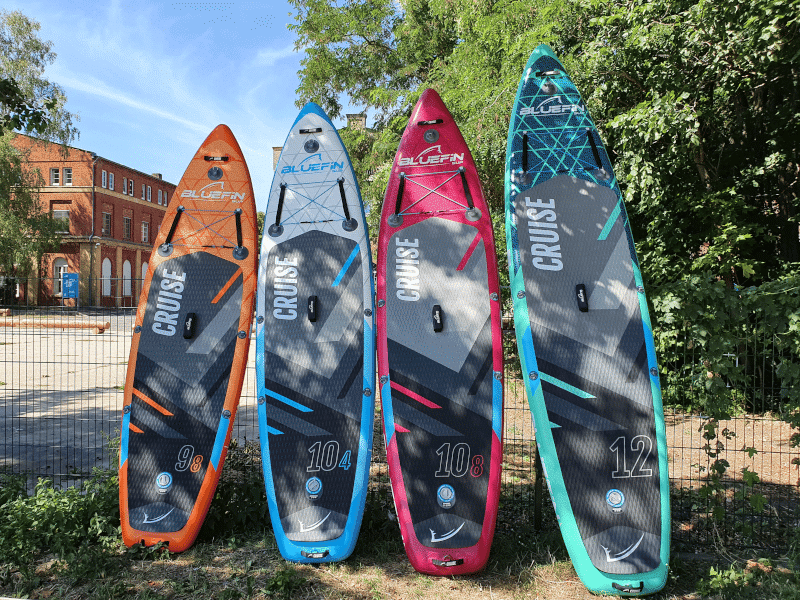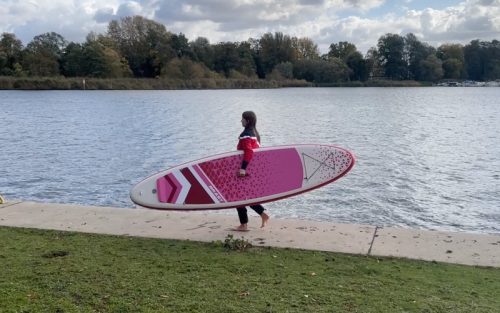For the perfect stand up paddleboard (SUP) size, consider your weight, skill level, and paddling type. Key factors include length, width, and thickness, influencing stability, speed, and maneuverability. Different activities require specific SUP dimensions: longer boards are ideal for touring, shorter ones for surfing, and wider boards for yoga and fitness. A SUP sizing chart helps you select a board that supports your weight and matches your paddling needs, ensuring an optimal experience on the water.
Are you ready to dive into the world of Stand Up Paddling (SUP) but unsure about the right board size?
Choosing the perfect SUP size is crucial for your stability, performance, and overall enjoyment on the water.
Whether you’re a beginner or an experienced paddler, understanding the impact of length, width, and thickness on your SUP experience is key.
Our comprehensive SUP Sizing Chart article breaks down everything you need to know to make an informed decision.
Find the ideal SUP size tailored to your weight, skill level, and paddling style.
Embark on your SUP adventure with confidence!
- The right SUP size is essential for stability and performance, depending on your body dimensions and paddle boarding goals.
- Length, width, and thickness are key factors to consider when selecting your SUP, influencing stability, speed, and maneuverability.
- Different paddle board activities call for specific board dimensions, with longer boards being ideal for touring and shorter boards for surfing.

Table of Contents
- 1 Table: SUP Sizes
- 2 Understanding SUP Sizes and Dimensions
- 3 Choosing a SUP Based on Activity Type
- 4 Selecting a SUP for Different Skill Levels
- 5 FAQ
- 5.1 What factors should I consider when choosing the right size paddle board?
- 5.2 How does a rider’s weight affect the volume of the SUP required?
- 5.3 What is the ideal paddle board size for beginners to maintain balance?
- 5.4 Can the width of a paddle board impact its stability and performance?
- 5.5 What are the implications of paddle board thickness for overall usage?
- 5.6 How does the length of a paddle board influence maneuverability and speed?
Table: SUP Sizes
When selecting the dimensions of your Stand Up Paddleboard (SUP), consider your weight, skill level, and the type of paddling you’ll be doing.
Here’s a structured table to guide your decision.
| SUP Model | Length | Width | Thickness | Volume | Weight Capacity |
|---|---|---|---|---|---|
| All-Around | 10′ to 12′ | 31″ – 34″ | 5″ – 6″ | Medium to High | Up to 300 lbs |
| Surfing | 8′ – 10′ | 29″ – 32″ | 4″ – 5″ | Low to Medium | 150 – 200 lbs |
| Touring | 11’6″ – 14′ | 28″ – 32″ | 6″ – 7″ | High | 275 – 350 lbs |
| Racing | 12’6″ – 14′ | 24″ – 28″ | 6″ – 8″ | Very High | 250 – 325 lbs |
| Yoga & Fitness | 10′ – 12′ | 32″ – 36″ | 5″ – 6″ | Medium to High | 275 – 350 lbs |
Bear in mind that length impacts navigation and speed, width contributes to stability, and thickness influences buoyancy and load capacity.
- Beginners should lean towards a bit more length and width, like the all-around board, to gain stability as they learn.
- More experienced paddlers can opt for performance-oriented shapes, like a racing SUP, which are longer and have less width for speed and efficiency.
- For specific activities like SUP Yoga, boards tend to be wider for increased balance, supporting poses and exercises hence the yoga & fitness SUP.
The volume correlates with buoyancy, allowing you to choose a board that can support your weight and cargo effectively.
Remember to factor in the weight capacity to ensure the SUP can support both your body weight and any additional gear you might bring.
Check here our reviews of the best paddle boards
Understanding SUP Sizes and Dimensions
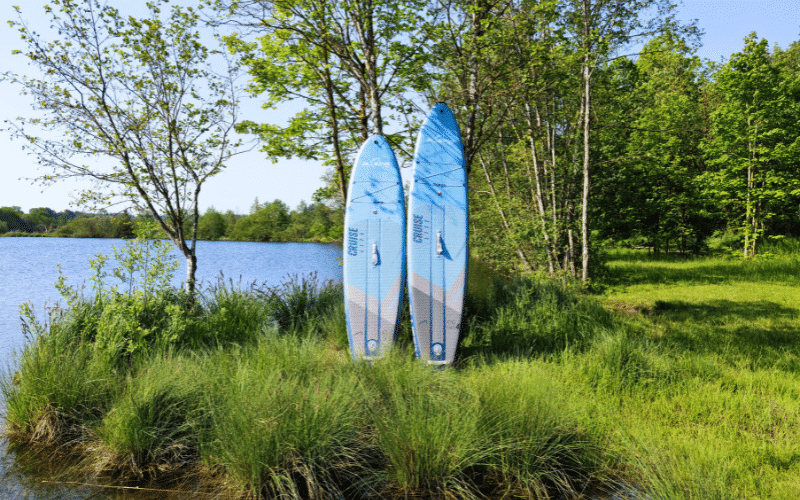
Selecting the correct stand up paddle board (SUP) depends on the right balance of length, width, thickness, volume, and weight capacity to meet your needs on the water.
Here’s a breakdown of these dimensions to help you make an informed choice.
Determining the Right Length
Your board length affects maneuverability and speed.
A shorter board (< 10 feet) is ideal for surfing and is easier to turn, making it suitable for children or beginners requiring better control.
For versatile use, a medium-sized board, approximately 10 to 12 feet, is most common and offers stability for flat-water paddling and some waves.
Longer boards (> 12 feet), aim toward touring or racing, provide increased glide and speed, optimal for long-distance paddling.
Width for Stability and Performance
Board width is crucial for balance.
A wider board (31-36 inches) provides more stability, which is beneficial for beginners or if you’re using it for yoga and fishing.
On the flip side, a narrower board (<30 inches) might offer less stability but better performance in terms of speed and tracking, best suited for intermediate to advanced paddlers focusing on touring or racing.
Board Thickness and Volume
The thickness of a SUP impacts its overall volume and ability to float.
Typically, a board with a 6-inch thickness can support more weight and remains more rigid on the water.
This contrasts with a 4-inch thick board, which might submerge more, suitable only for lighter paddlers.
Higher board volume indicates a higher weight capacity, ensuring the board remains buoyant for a heavier paddler.
Board Weight and Capacity
The SUP should accommodate your weight plus any gear you plan to carry.
Pay close attention to the weight capacity and maximum weight capacity of a board.
A board with a high weight limit will ensure stability and performance aren’t compromised.
Manufacturers usually provide a SUP size and weight chart indicating the suitable paddler weight for their boards.
Remember, it’s not only about your weight but the combined load the board can comfortably support.
Check here our reviews of the best paddle boards for heavy riders
Choosing a SUP Based on Activity Type
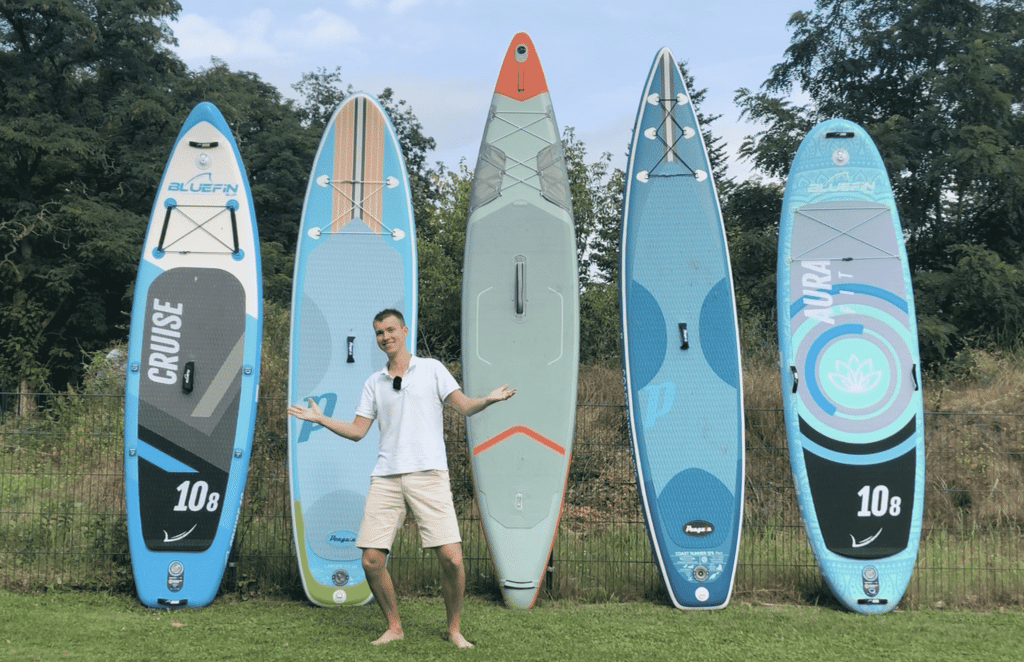
When selecting a stand-up paddleboard (SUP), it’s crucial to consider the specific activities you’ll engage in.
The type of SUP you choose directly impacts your enjoyment and performance, whether you’re touring long distances, catching waves, racing, practicing yoga, or fishing.
Touring SUP Considerations
Touring SUPs are designed for long-distance paddling and expedition use.
They are typically longer and have a pointed nose or “displacement hull,” which is ideal for slicing through water and increasing speed.
These boards offer improved performance and buoyancy, which make them suitable for SUP touring and recreational paddling.
Pay close attention to the volume and weight capacity to ensure you have enough support for your gear on extended trips.
Check here our reviews of the best touring paddle boards
SUPs for Surfing and Racing
SUP surfing demands a shorter board with a planing hull that’s more maneuverable on waves.
Boards for surfing often range from as short as 8 feet.
For racing, you need a board that combines speed with stability, often longer and narrower than all-around boards.
The design is aimed at achieving top speed and cutting down on drag, crucial for competitive racing performance.
Yoga and Fishing on SUPs
Yoga and fishing require a stable platform, so yoga SUPs and fishing SUPs are generally wider with a large deck space to enhance balance.
Look for boards labeled as “all-around SUP” if you’re interested in yoga or fishing activities.
These SUPs provide a stable base that is crucial for maintaining poses or reeling in fish.
Additional features like paddle holders and mounts for yoga straps or fishing rods can further enhance your experience.
Check here our reviews of the best yoga paddle boards
Selecting a SUP for Different Skill Levels
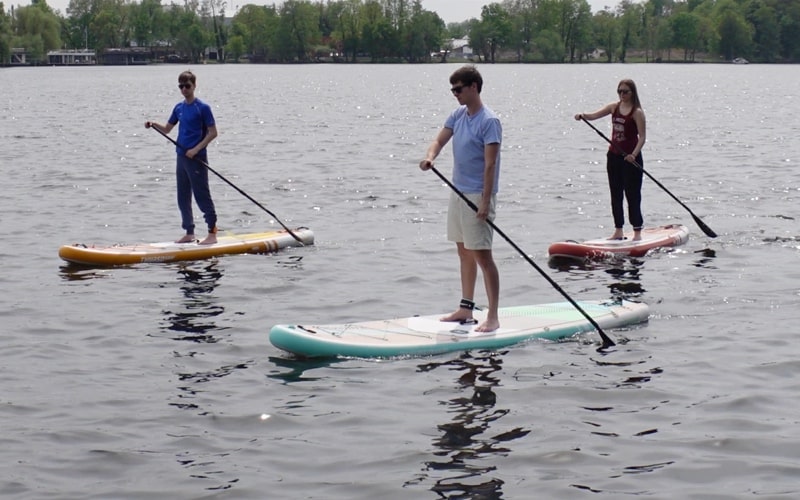
When choosing a stand-up paddleboard (SUP), your skill level significantly influences the size and type of board that will offer you the best experience on the water.
The right size enhances stability for beginners, maneuverability for intermediate paddlers, and performance for experts.
SUPs for Beginners
As a beginner, you should look for a beginner paddle board that promises a high degree of stability.
A wider and longer board, typically around 10 to 11 feet in length and 32 to 36 inches in width, will help you feel more stable on the water.
These dimensions offer a generous surface area, making it easier for you to balance and control the board.
Additionally, boards with higher capacity can support your weight plus any additional gear you may bring along more effectively.
Check here our reviews of the best beginner paddle boards
Boards for Intermediate Paddlers
Once you’ve gained some experience and are more comfortable with your balance and paddling technique, you can transition to a board that offers a balance between stability and maneuverability.
Intermediate paddlers often thrive on boards that range from 10 to 12 feet, with a slightly narrower width, such as 30 to 32 inches.
This size allows for smoother transitions and more agility in the water without significantly sacrificing stability.
Advanced Paddler Options
If you’re an expert, performance and responsiveness are key.
Advanced paddlers prefer hardboards that offer the greatest maneuverability and speed.
These are often narrower and longer—12 feet or more—and have a streamlined shape for efficient gliding and cutting through the water.
While these boards have a lower capacity for stability, they make up for it in agility and speed, allowing you to handle more challenging conditions and competitions with ease.
Remember that a higher skill level increases the enjoyment and control you have over such a specialized board.

FAQ
What factors should I consider when choosing the right size paddle board?
When selecting a paddle board, it’s important to consider your weight, skill level, and the activities you plan to use it for. Your height can also play a role, but it’s your weight that primarily determines the board’s volume needed for proper flotation.
How does a rider’s weight affect the volume of the SUP required?
A rider’s weight significantly influences the amount of volume a SUP should have. A heavier rider requires a board with higher volume for adequate flotation and stability, while a lighter rider can manage with less volume.
What is the ideal paddle board size for beginners to maintain balance?
Beginners should look for a SUP size that offers ample stability. Typically, a board measuring 10-11 feet long, 32-36 inches wide, and around 6 inches thick will provide a beginner-friendly experience.
Can the width of a paddle board impact its stability and performance?
Yes, the width of a paddle board greatly impacts its stability. Wider boards provide more stability, which is beneficial for beginners. The trade-off is that wider boards can be slower and less maneuverable.
What are the implications of paddle board thickness for overall usage?
Paddle board thickness affects the volume and weight capacity of the board. A thicker board can support more weight, which increases stability but also makes the board heavier and more challenging to carry.
How does the length of a paddle board influence maneuverability and speed?
The length of a paddle board determines its speed and maneuverability. Longer boards glide through the water more efficiently, offering better speed and tracking for touring or racing. Shorter boards are more agile, making them ideal for surfing and quick turns.

